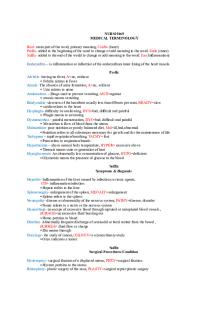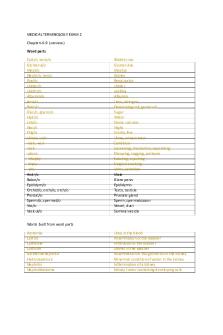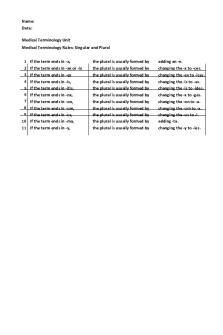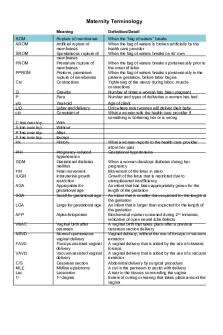Medical terminology Modules PDF

| Title | Medical terminology Modules |
|---|---|
| Course | Medical Terminology |
| Institution | University of Nevada, Las Vegas |
| Pages | 158 |
| File Size | 3 MB |
| File Type | |
| Total Downloads | 52 |
| Total Views | 146 |
Summary
Module Notes...
Description
MODULE 1 1.2 ORIGINS OF MEDICAL TERMS Practice of medicine foundation in Western culture can be traced to the ancient Greek, Roman, and Arabic civilizations. Most of the medical terms in use today have components that are of Greek or Latin origin 1.3 EPONYMS AND ACRONYMS Eponyms derive from the name of a person—often a physician or scientist who was first to identify a certain condition or to devise a medical procedure.
An acronym is an abbreviation that we pronounce as if it were a word instead of speaking each letter.
1.4 HEIMLICH MANEUVER Example of an eponym. Describes a technique named after the American physician, J.H. Heimlich. 1.6 TERMS OF ENGLISH ORIGIN AND ABBREVIATIONS Many of the new medical terms derive from English.
Sometimes medical conditions and procedures are more commonly known by their abbreviations rather than by their full medical terms (MRI).
2.2 STRATEGY FOR LEARNING MEDICAL TERMS Analyze words by diving them into component parts. Relate the medical terms to the structure and function of the body. Be aware of spelling and pronunciation problems. 3.3 WORD ROOT, SUFFIX The word root is the main part, or foundation, of the word; it contains the word's essential meaning. Word roots often indicate a body part.
The suffix is the word ending. Attaching a suffix to the end of a word modifies the word's meaning. Suffixes frequently indicate a procedure, condition, or disease.
4.1 COMBINING VOWELS The most common combining vowel is o. The combining vowel has no meaning; it serves to ease pronunciation in terms built using a suffix that does not already begin with a vowel.
A combining vowel is not used before a suffix if the suffix already begins with a vowel.
5 . 1PREFI X An o t he rwo r dp a r tt h a ti sc o mmo n l yu s e di nt hec on s t r u c t i ono fme d i c a lt e r msi st h e pr e fix . Th ep r e fixi sa ne l e me n tl o c a t e da tt h eb e g i n n i n go fat e r m.
Prefixes often indicate number, position, direction, time, or negation
6 . 1USI NGSTUDYCARDS Co l o rc o d e d . MODULE2 1 . 2ATOMSMOLECULESORGANELLES Ana t o mi st h eb a s i cu ni to fa l lma t t e r .The r ea r ema n yt yp e so fa t o ms , e a c hwi t hi t so wn na me , ma s s , a n ds i z e .
A molecule is composed of one or more atoms. Molecules are the smallest particle of a substance that retains all the properties of that substance. When molecules join together, they form more complex structures such as an organelle. Organelles are membrane-bound structures that perform specific functions within each cell. Organelles are to cells what an organ is to the body.
1 . 3THECELL
(cyt/o)
Th ef un d a me nt a lu n i t o fa l ll i vi n gt i s s u e . Ea c hc e l lha sa no u t e rc o v e r i n g( c e l l me mbr a ne )t h a tp r o t e c t st h ee n c l o s e ds t r u c t u r e sa n dr e g u l a t e st h ee x c h a n g eo fma t e r i a l s be t we e nt h ec e l la n di t se n v i r o n me n t . 1 . 4NUCLEUSANDCYTOPLASM Inside the cell membrane is a gelatinous substance called cytoplasm(cyt/o =
cell; -plasm = formation) that holds the cell's organelles. The work of the cell is carried out within the cytoplasm. The nucleus(nucle/o) is the central controlling body of the cell. The nucleus regulates cell reproduction and determines the structure and function of the cell.
2 . 1CHROMOSOMES Al lc e l l s , wi t ht h ee x c e p t i o no fma t ur es e xc e l l s ,h a v e4 6c hr omo s ome s —f o r mi n g2 3 pa i r s .Chr o mo s ome sa r er od l i k es t r u c t u r e swi t h i nt h enu c l e u s .
Egg and sperm cells have half that number; that way, the mature sex cells unite during fertilization, and each contributes 23 chromosomes to the embryo.
2 . 2GENESANDDNA Ch r o mo s ome sc o n t a i nr e g i o n sc a l l e dg e ne s . Se v e r a lt h ou s a n dg e ne sa r ea r r a n g e di na n or d e r l ys e q u e n c eo ne v e r yc h r omo s ome .
Each gene contains a chemical called deoxyribonucleic acid (DNA). DNA is like a code that directs the activities of the cells, such as cell division and protein synthesis. chrom/oactually means color and that the suffix -some means body.
2 . 3KARYOTYPE
A karyotype is a microscopic photograph of chromosomes within the nucleus and is used to study the form, number, size, and arrangement of these cellular structures (kary/o = nucleus; -type = picture or classification). This type of analysis is often performed to ensure that a developing fetus has the correct number of chromosomes per cell. An abnormal karyotype can indicate significant challenges for the fetus, such as Edwards syndrome (trisomy 18 syndrome).
2 . 4CHROMOSOMALABNORMALI TI ES Down syndrome is one example of a congenital condition caused by the presence of an extra chromosome—that is, 47 instead of the normal number of 46. Amazingly, we even know that the extra number 21 chromosome is the one that results in Down syndrome, also called trisomy 21 syndrome.
3 . 1MI TOCHONDRI A
Mitochondria provide the main source of energy for a cell and have both an inner and an outer membrane. The inner membrane is convoluted, forming folds called cristae (sing. crista). The energy level of the cell is related to the number of mitochondria and cristae it contains.
3 . 2CATABOLI SM Mi t oc ho n d r i ap r o du c ee n e r g yf o rt h eb o d ywi t ha process known
as catabolism (cata- = down; bol/o = to cast; -ism = process or condition). Complex nutrients are broken down into simpler substances. Those substances are then burned in the presence of oxygen, and the released energy is made available for the work of the cell.
3 . 4ENDOPLASMI CRETI CULUM
The endoplasmic reticulum is a network of canals distributed throughout the cytoplasm. Ribosomes attached to the endoplasmic reticulum manufacture proteins for the cell.
3 . 5METABOLI SM
Ribosomes synthesize, or build up, proteins within the cell, converting simple proteins into more complex compounds in a process known as anabolism (ana= up; bol = to cast; -ism = process or condition). This process supports new cell growth. Metabolism includes both anabolism and catabolism and is the sum of all chemical processes that happen in the cells of living organisms to sustain life. These processes allow organisms to grow and reproduce, maintain their structures, and respond to their environments. Meta- means change.
3 . 8SPECI ALI ZEDFUNCTI ONOFCELLS
Muscle cells make it possible for the body to move because they can contract. Muscle cells are made up of tiny fibers that forcefully slide together. Epithelial cells form the linings of the internal organs and the outer surface of the skin covering the body. This type of cell is usually flat and square. Nerve cells have long extensions from the cell body that help transmit impulses to and from the brain. Fat cells tend to be large cells with little cytoplasm and a nucleus that is displaced to one side to allow for the storage of fat.
4 . 1TYPESOFHUMANTI SSUE A tissue (hist/o) is a collection of similar cells that perform a particular
function. In turn, different types of tissue can combine to form an organ. There are four major types of human tissue: epithelial, connective, muscle, and nerve. Epithelial tissue, such as that shown in the illustration, forms the outer covering (epi- = above) of the body and lines the body's cavities and internal organs, or viscera (viscer/o). It offers protection from injury and helps defend against disease-producing microorganisms. Epithelial tissue also performs the functions of absorption, secretion, and sensation.
4 . 3MUSCLETI SSUE
Muscle tissue is composed of long, slender cells called fibers, which, by contracting, enable movement of the parts and organs of the body. There are three types of muscle tissue. Skeletal muscle tissue attaches to the bone and is also called voluntary muscle tissue because its contractions are consciously controlled. Smooth muscle tissue, found in the walls of hollow internal structures such as the stomach, intestines, and blood vessels, is involuntarymuscle tissue. A third type—cardiac muscle tissue—comprises the wall of the heart and is also involuntary.
4 . 4CONNECTI VETI SSUE Connective tissue supports and shapes the body, binds the internal organs in place, and transports substances between body parts. Examples of connective tissue include bone, cartilage (chondr/o), adipose, or fatty tissue (adip/o), and blood.
4 . 5NERVETI SSUE Nerve (neur) tissue is found in the nerves, spinal cord, and brain and coordinates and controls body activities. All living cells have the ability to react to stimuli. Nerve tissue is specialized to react to stimuli and to conduct impulses to various organs in the body, which brings about a response to the stimulus.
4 . 6ORGANS
A tissue is a group of similar cells working together to do a specific job. Similarly, organs are groups of different types of tissue that work together to do a specific job. The medical term for internal organs is viscera (sing. viscus). For example, the stomach—by means of its component epithelial, muscle, and nerve tissues—is able to secrete juices that aid digestion and to move bulk into the intestines. Many of the body's organs—the lungs, kidneys, and ovaries, to name a few— exist in pairs; each one of the paired organs can function independently of the other.
5 . 2BODYS YSTEMS
A body system consists of a group of organs that work together to perform related functions. The digestive system: the mouth, throat or pharynx, esophagus, gallbladder, liver, pancreas, small intestine, and large intestine. The body systems also include the urinary (urin/o = urine; -ary = pertaining to), or excretory; respiratory (re- = again; spir/o = to breathe); reproductive; endocrine (endo- = within; -crine = to secrete); nervous and the special senses of vision and hearing; cardiovascular (cardi/o = heart; vascul/o = vessel; -ar = pertaining to), or circulatory; musculoskeletal (muscul/o = muscle; skelet/o = skeleton; -al = pertaining to); and the skin or integumentary (integument = covering) system.
5 . 5URI NARYSYSTEM
The urinary system consists of all of the organs involved in the production and elimination of urine.
These organs include the kidneys, the ureters (tubes leading from the kidneys to the urinary bladder), the urinary bladder, and the urethra (tube through which urine passes from the bladder to the outside of the body).
5 . 8RESPI RATORYSYSTEM The organs of the respiratory system include the nose, pharynx, larynx, or voice
box, trachea (trache/o), or windpipe, bronchial tubes, and lungs. Air is breathed in through the nose and warmed in the pharynx and trachea. Oxygen enters the bronchial tubes and is exchanged for carbon dioxide in the lungs. At the end of respiration, carbon dioxide is exhaled from the body.
6 . 1ENDOCRI NESYSTEM This reaction is caused by an increase in the production of endorphins, which
are found in the adenohypophysis (part of the pituitary gland), and hypothalamus. Located in the brain, these glands are part of the endocrine system. The endocrine system functions to manufacture special chemicals called hormones, secreting them into the bloodstream where they affect body processes such as growth and metabolic rate. Organs also include the thyroid gland, sex glands (the ovaries and testes), adrenal glands, pancreas, and parathyroid glands.
6 . 2CARDI OVASCULARANDL YMPHATI CS YSTEMS
Hormones are delivered to various sites via the blood and lymph, through the cardiovascular and lymphatic systems. These systems transport fluids to and from the body's cells. Pumped by the heart, blood flows through a closed network of arteries, veins, and capillaries, carrying respiratory gases and nutrients. Organs of the lymphatic system—the lymphatic vessels, nodes, spleen, and thymus—play important roles in immunity.
6 . 3MUSCULOSKELETALSYSTEM
The musculoskeletal system provides both a frame for the body, as well as its mechanism for movement. The skeleton, consisting of highly specialized connective tissue (bone and cartilage), provides the supporting framework for the muscles and organs. Muscles, which can be skeletal, visceral, or cardiac, are the body's organs of movement. Acting together, the skeleton and muscles produce most of the body's movements.
6 . 5NERVOUSSYSTEM This intricate network of structures transmits impulses to activate, coordinate, and control all of the body's functions. The nervous system consists of the brain, spinal cord, nerves, and groups of nerves called ganglia (sing., ganglion). The special sense organs—the eyes and the ears—receive and convert external stimuli to nerve impulses, producing vision and hearing.
6 . 6I NTEGUMENTARYSYSTEM
The skin and its accessory structures—hair, nails, sweat glands, and sebaceous glands—are known as the integumentary system. In addition to their special role as a sense organ, the skin and its accessory organs provide protection to the internal organs, help regulate the body's temperature, and aid in the excretion of certain waste products.
6 . 7REPRODUCTI VESYSTEM
The organs of the reproductive system enable the conception and development of offspring.
In women, the reproductive organs are the ovaries, fallopian tubes, uterus, or womb, vagina, and mammary glands. In men, the reproductive organs include the testes (sing., testis, epididymis, vas deferens, seminal vesicles, ejaculatory duct, prostate, and penis.
7 . 2MAJ ORBODYCAVI TI ES The major body cavities are the cranial, thoracic, abdominal, pelvic, and spinal cavities.
7 . 3DORS ALCAVI TY Because of their location at the back, or posterior, of the body, the cranial
(crani/o = skull; -al = pertaining to) and spinal (spin/o) cavities are referred to as dorsal cavities. The cranial cavity contains the brain and the pituitary gland. The nerves of the spinal cord are found within the spinal cavity, which is also called the spinal canal.
7 . 4VENTRALCAVI TI ES The thoracic, abdominal, and pelvic cavities are located at the anterior, or front, of the body and are thus considered ventral body cavities.
7 . 6THORACI CCAVI TY The thoracic cavity is the space between the base of the neck and
the diaphragm where the lungs, heart, esophagus, trachea, bronchial tubes, and thymus gland are housed. The thoracic cavity is divided into two smaller cavities—the pleural cavity and the mediastinum. The pleura is a membrane that folds back onto itself to form a double-layered membrane structure. The inner membrane is the visceral pleura; it covers the lungs and adjoining structures. The outer membrane is the parietal pleura; it is attached to the chest wall. The thin space between the two pleural layers is known as the pleural cavity; it normally contains a small amount of pleural fluid. The mediastinum is the area outside of and between the lungs.
7 . 7ABDOMI NALCAVI TY The abdominal cavity is the space below the chest containing the stomach,
small and large intestines, kidneys, liver, gallbladder, pancreas, and spleen. The wall of the abdominal (abdomin/o + -al) cavity is lined by an extensive doublelayered membrane called the peritoneum. Note that a portion of the large intestines extends down into the pelvic area. The pelvic (pelv/i) cavity is the area below the abdomen (abdomin/o) and contains the urinary bladder, the reproductive organs, part of the intestines, and the rectum. Because the pelvic cavity is not separated from the abdomen by a dividing structure, these spaces are often jointly referred to as the abdominopelvic cavity.
8 . 2SECTI ONI NGTHEABDOMENANDPEL VI SFORORGANLOCATI ON
The abdominopelvic area may be divided into nine regions by imposing four imaginary lines, in a tic-tac-toe pattern, over its anterior surface. These anatomic divisions, or regions, of the area help health care providers locate the placement of the internal organs and serve as useful points of reference for describing health problems. The imaginary lines that divide the abdominopelvic area form three upper, three middle, and three lower regions. The upper right and left sections are the hypochondriac regions; these are separated by the epigastric
region(epi- = above; gastr/o = stomach; -ic = pertaining to)—the area directly above the stomach. The middle right and left sections are the left and right lumbar regions. Between these two regions lies the umbilical region where the navel, or umbilicus (umbilic/o), is located. The lower right and left sections are called the inguinal region or iliac regionbecause of their proximity to the ilium (ili/o = ilium; -iac = pertaining to), which is the upper portion of the hip bone and groin ( inguin/o). The hypogastric region (hypo- = below) is the lower middle section below the umbilicus.
8 . 5RI GHTANDLEFTQUADRANTS
The abdominopelvic area can also be divided into quadrants—four sections—by drawing imaginary vertical and horizontal lines through the umbilicus. The right upper quadrant (RUQ) contains the right lobe of the liver, gallbladder, part of the pancreas, portions of the small and large intestines, and the right kidney. In the left upper quadrant (LUQ), we find the left lobe of the liver, stomach, spleen, part of the pancreas, portions of the large and small intestines, and the left kidney. The right lower quadrant (RLQ) of the abdominopelvic region contains parts of the small and large intestines, appendix, right ureter, the right fallopian tube and ovary in women, and the right spermatic duct in men. Located in the left lower quadrant (LLQ) are portions of the intestinal tract, left ureter, the left fallopian tube and ovary in women, and the left spermatic duct in men.
9 . 2SPI NALCOLUMN The spinal column is a flexible structure that extends from the base of the skull down the length of the back. In the adult, the spinal column consists of 26 bones or vertebrae (sing., vertebra) that are separated by round, flat cartilage pads called disks. These disks, then, can be said to exist in the intervertebral (inter= between; vertebr/o = vertebrae; -al = pertaining to) spaces.
9 . 3REGI ONSOFSPI NALVERTEBRAE The spinal vertebrae are divided into five regions. Seven vertebrae are in
the cervical(cervic/o), or neck, region (numbered C1 to C7). Twelve vertebrae, each joined to a rib, comprise the thoracic region of the spinal column (numbered T1 to T12). The term thoracic means pertaining to (ic) the thorax (thorac/o). The area of the spine between the ribs and the pelvis is known as the lumbar (lumb/o = lower back) region, in which there are five vertebrae (you guessed it—numbered L1 to L5). The sacral (sacr/o) area of the spinal column is one composite bone formed by the fusion of five vertebrae. The coccygeal (-eal = pertaining to) region at the base of the spine, consists of one small bone—the coccyx (coccyg/o) or tailbone—formed from the union of four vertebrae.
9 . 4LUMBOS ACRALANDCERVI COTHORACI CREGI ON Sometimes, spinal regions are identified in combination, such as the lumbosacral (lumb/o + sacr/o + -al) region, which includes both the lumbar vertebrae ...
Similar Free PDFs

Medical terminology Modules
- 158 Pages

Medical Terminology
- 50 Pages

Medical Terminology
- 6 Pages

Medical Terminology
- 2 Pages

Medical Terminology
- 4 Pages

Medical Terminology EXAM 2
- 4 Pages

Medical Terminology Terms
- 22 Pages

Medical Terminology-Plurals Quiz
- 3 Pages

Medical terminology 17
- 4 Pages

Med term - medical terminology
- 20 Pages

Medical Terminology Final Exam
- 5 Pages

Medical terminology 2
- 3 Pages

Medical terminology 22
- 2 Pages

Medical Terminology 2018
- 3 Pages

Medical terminology 6
- 2 Pages
Popular Institutions
- Tinajero National High School - Annex
- Politeknik Caltex Riau
- Yokohama City University
- SGT University
- University of Al-Qadisiyah
- Divine Word College of Vigan
- Techniek College Rotterdam
- Universidade de Santiago
- Universiti Teknologi MARA Cawangan Johor Kampus Pasir Gudang
- Poltekkes Kemenkes Yogyakarta
- Baguio City National High School
- Colegio san marcos
- preparatoria uno
- Centro de Bachillerato Tecnológico Industrial y de Servicios No. 107
- Dalian Maritime University
- Quang Trung Secondary School
- Colegio Tecnológico en Informática
- Corporación Regional de Educación Superior
- Grupo CEDVA
- Dar Al Uloom University
- Centro de Estudios Preuniversitarios de la Universidad Nacional de Ingeniería
- 上智大学
- Aakash International School, Nuna Majara
- San Felipe Neri Catholic School
- Kang Chiao International School - New Taipei City
- Misamis Occidental National High School
- Institución Educativa Escuela Normal Juan Ladrilleros
- Kolehiyo ng Pantukan
- Batanes State College
- Instituto Continental
- Sekolah Menengah Kejuruan Kesehatan Kaltara (Tarakan)
- Colegio de La Inmaculada Concepcion - Cebu
